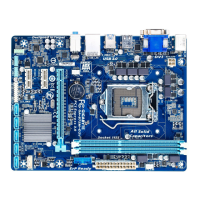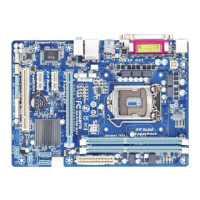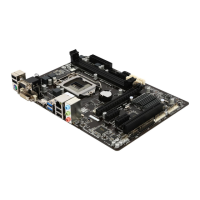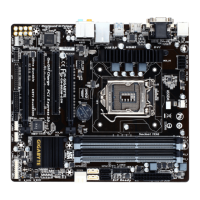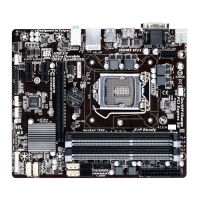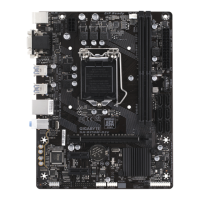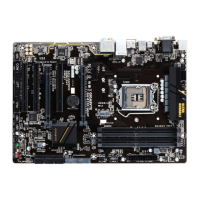Do you have a question about the Gigabyte GA-B75M-HD3 and is the answer not in the manual?
Declaration of conformity with FCC Part 15 rules for digital devices.
Compliance with EMC Directive requirements for electronic equipment.
Statement on compliance with RoHS directive regarding hazardous substances.
Indicates conformity with EU directives and safety standards.
Legal statement regarding copyright protection for the manual.
Important notes on accuracy, changes, and liability for manual content.
Guide to identifying the motherboard's revision number for updates.
Diagram showing the physical layout and components of the motherboard.
List of items included in the motherboard package.
Schematic representation of the motherboard's internal architecture and connections.
Essential safety and handling guidelines before installing hardware components.
Detailed technical specifications of the motherboard's CPU, chipset, memory, and ports.
Step-by-step guide for safely installing the Central Processing Unit onto the motherboard.
Instructions for installing DDR3 memory modules into the motherboard sockets.
Guide for installing expansion cards like graphics or sound cards into PCI Express slots.
Detailed description of rear I/O ports including USB, PS/2, D-Sub, DVI-D, and HDMI.
Explanation of onboard audio jacks and RJ-45 LAN port functionality.
Diagram and list of internal motherboard connectors and their functions.
Details on connecting the 24-pin ATX and 4-pin ATX 12V power connectors.
Information on fan headers and the CMOS battery for BIOS settings.
Description and pinouts for SATA 6Gb/s and SATA 3Gb/s connectors.
Guide to connecting chassis front panel components like power, reset, and LEDs to the motherboard header.
Instructions for connecting front panel audio and USB ports to motherboard headers.
Description of COM and LPT headers for connecting serial and parallel devices.
Instructions on using the Clear CMOS jumper to reset BIOS settings to factory defaults.
Description of the initial boot screen and function key assignments.
Overview of the BIOS Setup main menu, navigation, and key BIOS sections.
Summary of the main BIOS configuration menus: M.I.T., System, BIOS Features, Peripherals, Power Management, Save & Exit.
Displays current status of CPU/memory frequencies and parameters.
Settings for processor graphics clock, CPU clock ratio, and memory frequency.
Detailed CPU core settings including Turbo Boost, core ratios, and power management features.
Settings for XMP profiles, memory multiplier, timings, and performance enhancement.
Displays system voltages, temperatures, fan speeds, and warnings.
Controls CPU and system fan speeds based on temperature or manual settings.
Contains settings for PEG Gen3 Slot Configuration and Legacy Benchmark Enhancement.
Selects the default language for the BIOS interface.
Allows setting the current system date and time.
Defines user access levels for BIOS settings.
Provides information on connected SATA devices and allows port configuration.
Configures the system's boot order for various devices.
Sets password requirements for system startup or BIOS entry.
Enables Intel VT-x, VT-d, and CSM for legacy boot processes.
Selects the operating system boot mode (UEFI, Legacy, or Hybrid).
Sets administrator and user passwords for BIOS access and system startup.
Enables SATA controllers and selects IDE or AHCI mode.
Configures USB 3.0/2.0 controllers, modes, and streams.
Specifies primary display output and configures onboard graphics.
Configures serial and parallel ports via the Super IO chip.
Sets a specific time for the system to automatically power on.
Controls system power consumption in S5 (shutdown) state for energy efficiency.
Allows system power-on via PS/2 keyboard or mouse events.
Determines system state after AC power loss.
Saves BIOS changes to CMOS and exits the setup utility.
Exits BIOS setup without saving any changes made.
Loads optimal BIOS default settings for system stability.
Saves and loads BIOS settings profiles.
Step-by-step guide for installing motherboard drivers from the included disk.
Legal notices regarding copyright, accuracy, and environmental compliance (RoHS, WEEE).
Information on accessing GIGABYTE's online technical support and service system.
Declaration of conformity with FCC Part 15 rules for digital devices.
Compliance with EMC Directive requirements for electronic equipment.
Statement on compliance with RoHS directive regarding hazardous substances.
Indicates conformity with EU directives and safety standards.
Legal statement regarding copyright protection for the manual.
Important notes on accuracy, changes, and liability for manual content.
Guide to identifying the motherboard's revision number for updates.
Diagram showing the physical layout and components of the motherboard.
List of items included in the motherboard package.
Schematic representation of the motherboard's internal architecture and connections.
Essential safety and handling guidelines before installing hardware components.
Detailed technical specifications of the motherboard's CPU, chipset, memory, and ports.
Step-by-step guide for safely installing the Central Processing Unit onto the motherboard.
Instructions for installing DDR3 memory modules into the motherboard sockets.
Guide for installing expansion cards like graphics or sound cards into PCI Express slots.
Detailed description of rear I/O ports including USB, PS/2, D-Sub, DVI-D, and HDMI.
Explanation of onboard audio jacks and RJ-45 LAN port functionality.
Diagram and list of internal motherboard connectors and their functions.
Details on connecting the 24-pin ATX and 4-pin ATX 12V power connectors.
Information on fan headers and the CMOS battery for BIOS settings.
Description and pinouts for SATA 6Gb/s and SATA 3Gb/s connectors.
Guide to connecting chassis front panel components like power, reset, and LEDs to the motherboard header.
Instructions for connecting front panel audio and USB ports to motherboard headers.
Description of COM and LPT headers for connecting serial and parallel devices.
Instructions on using the Clear CMOS jumper to reset BIOS settings to factory defaults.
Description of the initial boot screen and function key assignments.
Overview of the BIOS Setup main menu, navigation, and key BIOS sections.
Summary of the main BIOS configuration menus: M.I.T., System, BIOS Features, Peripherals, Power Management, Save & Exit.
Displays current status of CPU/memory frequencies and parameters.
Settings for processor graphics clock, CPU clock ratio, and memory frequency.
Detailed CPU core settings including Turbo Boost, core ratios, and power management features.
Settings for XMP profiles, memory multiplier, timings, and performance enhancement.
Displays system voltages, temperatures, fan speeds, and warnings.
Controls CPU and system fan speeds based on temperature or manual settings.
Contains settings for PEG Gen3 Slot Configuration and Legacy Benchmark Enhancement.
Selects the default language for the BIOS interface.
Allows setting the current system date and time.
Defines user access levels for BIOS settings.
Provides information on connected SATA devices and allows port configuration.
Configures the system's boot order for various devices.
Sets password requirements for system startup or BIOS entry.
Enables Intel VT-x, VT-d, and CSM for legacy boot processes.
Selects the operating system boot mode (UEFI, Legacy, or Hybrid).
Sets administrator and user passwords for BIOS access and system startup.
Enables SATA controllers and selects IDE or AHCI mode.
Configures USB 3.0/2.0 controllers, modes, and streams.
Specifies primary display output and configures onboard graphics.
Configures serial and parallel ports via the Super IO chip.
Sets a specific time for the system to automatically power on.
Controls system power consumption in S5 (shutdown) state for energy efficiency.
Allows system power-on via PS/2 keyboard or mouse events.
Determines system state after AC power loss.
Saves BIOS changes to CMOS and exits the setup utility.
Exits BIOS setup without saving any changes made.
Loads optimal BIOS default settings for system stability.
Saves and loads BIOS settings profiles.
Step-by-step guide for installing motherboard drivers from the included disk.
Legal notices regarding copyright, accuracy, and environmental compliance (RoHS, WEEE).
Information on accessing GIGABYTE's online technical support and service system.
| Non-ECC | Yes |
|---|---|
| Memory voltage | 1.5 V |
| Memory channels | Dual-channel |
| Memory slots type | DIMM |
| Number of memory slots | 2 |
| Supported memory types | DDR3-SDRAM |
| Maximum internal memory | 16 GB |
| Supported memory clock speeds | 1066, 1333, 1600 MHz |
| System bus rate | 5 GT/s |
| Processor socket | LGA 1155 (Socket H2) |
| Processor manufacturer | Intel |
| Compatible processor series | Intel Celeron, Intel Pentium |
| Maximum number of SMP processors | 1 |
| Number of SATA connectors | 6 |
| Number of SATA II connectors | 5 |
| Number of Parallel ATA connectors | 0 |
| USB 2.0 ports quantity | USB 2.0 ports have a data transmission speed of 480 Mbps, and are backwards compatible with USB 1.1 ports. You can connect all kinds of peripheral devices to them. |
| USB 3.2 Gen 1 (3.1 Gen 1) Type-A ports quantity | 4 |
| Audio chip | Realtek ALC887 |
| Cooling type | Passive |
| Component for | PC |
| Power source type | ATX |
| Motherboard chipset | Intel B75 |
| Audio output channels | 7.1 channels |
| Motherboard form factor | micro ATX |
| Compatible operating systems | Microsoft Windows 8/7/XP |
| Supported storage drive interfaces | SATA II, SATA III |
| DirectX version | 11 |
| Maximum resolution | 1920 x 1200 pixels |
| Parallel processing technology support | Not supported |
| PCI Express slots version | 2.0, 3.0 |
| PCI Express configurations | 1x16, 2x1 |
| PCI Express slots quantity | 3 |
| Trial software | Norton Internet Security |
| Cables included | SATA |
| Bundled software | Intel Rapid Start Technology\\r Intel Smart Connect Technology\\r Intel Small Business Advantage |
| Ethernet interface type | Gigabit Ethernet |
| BIOS type | AMI |
| ACPI version | 2.0a |
| BIOS memory size | 128 Mbit |
| Depth | 174 mm |
|---|---|
| Width | 244 mm |


